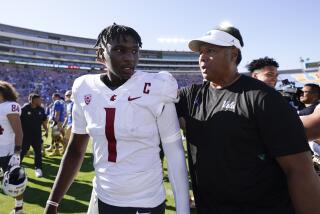Winless Navy Weighs Options : College football: Midshipmen are 0-10 going into today’s game against Army and the future doesn’t look bright.
- Share via
While Navy Football Coach George Chaump was speaking to his offense at a meeting this fall, one of his players fell asleep. After conducting his own version of reveille, Chaump learned the player had gone to bed at 4:30 a.m. before rising with the rest of the brigade of midshipmen at 6:15.
Chaump surveyed the 25 or so players in the room and learned that the average time for lights out the previous night had been 2:30 a.m.
Senior flanker B.J. Mason, the co-captain who recalled the incident, also noted: “You get that little sleep, get up at 6:30 and go to four or five classes, two formations and practice. It’s no wonder mental mistakes are made on the football field under these circumstances.”
Navy has made its share of them in compiling an 0-10 record, worst in the academy’s history going into its final game Saturday in Philadelphia against Army. But the academic stress in Annapolis has affected the football program in more fundamental ways.
Navy has a rich football history, with famed players such as Roger Staubach, Joe Bellino and George Welsh, and trips to the Rose, Sugar, Orange, Cotton, Holiday and Liberty bowls. But the last bowl was in 1981, Welsh’s last year as coach, when he left saying, “It isn’t possible to be better than 8-3 here.”
Now 8-3 would be cause for rejoicing.
“Something people are having trouble accepting, especially the alumni, is that the old years when Army and Navy were national powers are over,” Mason said. “It’s not that Army and Navy have changed, but football is big-time elsewhere.”
Al Vanderbush, Army’s athletic director, said much the same: “When I played (at West Point) in the late ‘50s, we were capable of competing for a national championship. But the academies stayed essentially the same while other schools got better. ... “
At least eight players who figured to be Navy starters are no longer playing football there. Fullback Kwame Moultrie gave up the sport to concentrate on his studies and linebacker Beau Laskey stopped playing as the result of shoulder injuries.
The others transferred before they entered their junior year, when they were still free of a service commitment, which had been five years, but is six beginning with the current plebe class.
The list is a formidable one: wide receiver Rob Holmberg (Penn State, sitting out a transfer year), linebacker Brad Brown (Vanderbilt, sitting out), defensive back Darrell Graham (Ball State, sitting out) and placekicker Todd Peterson (starting at Georgia). Two others, tailback Ivan Bullard and middle guard Pete Allen, left after their sophomore years.
“If they want to build a stronger football program, then the credit hours you take at the academy should be reduced,” Mason said. “I’m not sure the same situation exists even at the other academies. The Navy is getting very technical and the administration has emphasized that facet.
“I know the curriculum we have and the toll it takes on players. You take an average college lineman ... who starts as a freshman, and as a sophomore shows signs of being dominant at his position. He gives up his summers for cruises, is run ragged all year and finally transfers to the University of Whatever, where he can have his summers free and maybe become an all-American.
“Occasionally, guys are kicked out, but most of the time they tire of the struggle and are ready to move on.” The academy’s administration is aware of the stress. A survey completed last year at the request of Rear Adm. Virgil Hill, then the superintendent, recommended reducing the academic load. A moderate drop, from 150 credit hours to 145, was instituted, but upon a change of command, the new superintendent, Rear Adm. Thomas Lynch, suspended further changes while instituting a broader look at the entire academy program.
“Right now, we’re looking at everything -- academics, athletics, ethics, leadership,” said Cmdr. Mike John, the academy’s public-affairs officer. “We have gone to the fleet to see if we’re providing the best possible officers for their needs.
“Our goal is to train officers for war-fighting specialties. We want an officer to be able from Day One to go into a division and have an understanding of what his enlisted people are doing. We don’t want his eyes to glaze over if a petty officer says he has a problem. But if we’re going to keep excellence here, we want to be sure we’re doing the right thing. So we want input from the fleet and the Marines before we make changes.”
More to Read
Go beyond the scoreboard
Get the latest on L.A.'s teams in the daily Sports Report newsletter.
You may occasionally receive promotional content from the Los Angeles Times.










